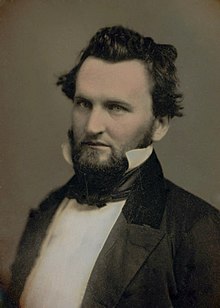John Neely Johnson
John Neely Johnson (born August 2, 1825 in Gibson County , Indiana , † August 31, 1872 in Salt Lake City , Utah ) was an American lawyer and politician . Johnson was the fourth governor of California from 1856 to 1858 and the Nevada State Supreme Court Justice from 1867 to 1871 . He was a member of the short-lived Know-Nothing Party and one of two California governors who managed to get elected to that office for a third party (the other was Hiram Johnson , 1911-1917 governor for the Progressive Party ).
youth
The young Johnson completed a law degree, which he successfully completed in Iowa at the age of 21. In July 1849, he interrupted his legal career, the California gold rush hit him too. He tried unsuccessfully as a gold digger. Then he settled in Sacramento and resumed his legal career. At the age of 25 (1850) he was elected District Attorney for the Sacramento District. Two years later he decided to become politically active and ran for the parliamentary elections in 1852 for the Democratic Party . After winning the election, he then moved to the California State Assembly as a representative for Sacramento .
MP
He first became known when he got violent against a journalist who wrote a negative article about him. In 1854 the clashes between the northern and southern states also reached California. The Democratic Party fell into two opposing camps, and Johnson was so frustrated with it that he left the party and joined the new so-called Know-Nothing Party . This party nominated him in 1855 for the upcoming gubernatorial elections against incumbent John Bigler , who was seeking a third term. Johnson won the following elections by a clear margin. At the same time, his party became the strongest force in all political bodies in the country.
governor
On January 9, 1856, Johnson became the fourth governor of California to take office. At the age of 30, he has remained California's youngest governor when he took office. His first goal as governor was to reduce the national debt that he had taken over from his predecessor. To this end, he wanted to drastically cut government spending. Johnson's tenure was overshadowed by civil war-like unrest in the city of San Francisco . There had been uprisings there by dissatisfied citizens against the open corruption even before his term in office . To achieve this goal, the citizens had come together to form a committee. As a result, there were violent clashes, including some lynchings, between the citizens and the local authorities, which the governor was at times powerless to counter. The crisis was eventually resolved with the Consolidation Act of 1856. This law united the city authorities of the city of San Francisco with those of the adjacent district. The aim was to contain corruption. The governor's poor crisis management in this so-called vigilante crisis cost him the trust of his party and his voters. He was not nominated again for the office of governor in the next elections. Soon afterwards came the end of his party, which was more or less absorbed into the Republican Party. It is also worth mentioning that under Governor Johnson the planning for the Capitol in Sacramento began.
Nevada
After his tenure ended, he left California and moved to the Utah Territory , which was soon redistributed. With this reallocation, the Nevada Territory was created . Soon after, in 1861, the American Civil War broke out. Against this background, there were considerations to make Nevada a federal state of the Union. Johnson was elected chairman of a Carson City convention to discuss the area's accession to the Union. With Johnson's help, this convention decided Nevada's accession to the Union, which took place on October 31, 1864. In 1867 Johnson was named a judge in the state's highest court by Henry G. Blasdel , the governor of Nevada. He held this office until 1871.
death
After leaving this post, his health deteriorated rapidly. He finally died on August 31, 1872 in Salt Lake City at the age of 47.
Individual evidence
- ↑ James P. Jackson,: Celebrating the Sesquicentennial of the Sacramento City Attorney's Office (.PDF; 5.0 MB) City of Sacramento. 1999. Archived from the original on June 20, 2007. Info: The archive link was inserted automatically and has not yet been checked. Please check the original and archive link according to the instructions and then remove this notice. Retrieved May 10, 2007.
- ↑ J. Neely Johnson Candidate Biography . JoinCalifornia. Retrieved May 10, 2007.
- ^ California State Library: Governor J. Neeley Johnson of California . State of California. Archived from the original on June 13, 2007. Info: The archive link was inserted automatically and has not yet been checked. Please check the original and archive link according to the instructions and then remove this notice. Retrieved May 10, 2007.
- ↑ 5 September 1855 General Election . JoinCalifornia. Retrieved May 10, 2007.
- ↑ The Vigilantes . San Francisco Virtual Museum. Retrieved May 10, 2007.
- ^ William T. Sherman: Memoirs of General WT Sherman . Penguin Books, New York 1875, ISBN 0140437983 .
- ^ John Wool: Letter Governor Johnson . June 5, 1856. Retrieved May 21, 2007.
Web links
- John Johnson at the National Governors Association (English)
- Biography John Neely Johnson at the California State Library (English)
- John Neely Johnson in the database of Find a Grave (English)
| personal data | |
|---|---|
| SURNAME | Johnson, John Neely |
| BRIEF DESCRIPTION | American lawyer and politician |
| DATE OF BIRTH | August 2, 1825 |
| PLACE OF BIRTH | Gibson County , Indiana |
| DATE OF DEATH | August 31, 1872 |
| Place of death | Salt Lake City , Utah |

